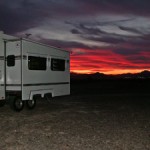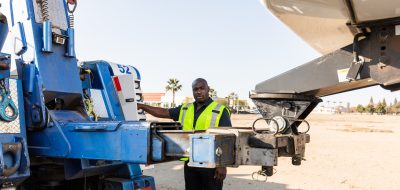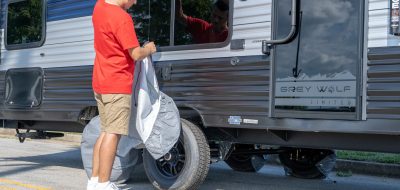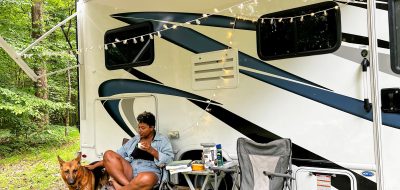 RVing through the Lone Star State
RVing through the Lone Star State
by Lee Barnathan
Stop for a moment and play a word-association game. The word is Texas. What comes to mind? Probably a thousand different words, but very likely something related to the enormity, vastness and gigantic expanse of our nation’s 28th state.
At 266,807 square miles, it’s larger than every European country but Russia. It’s so big that it takes two time zones to cover the width of the state. In January, it can be 90 degrees in the south with blizzard conditions in the panhandle, according to Encyclopedia Britannica.
So why RV through it? One answer comes from the Office of the Governor, Economic Development and Tourism’s Web site: “It’s like a whole other country.” Seven countries would be more like it. There are seven regions within this sprawling and amazingly diverse state, all rich with history, culture and flavors all their own.
There’s Big Bend Country, of which El Paso is the largest city. It’s the area of tumbleweeds, cactus and stars as far as the eye can see at night. There’s the South Texas Plains, the Tex-Mex area offering spicy food, rich culture and warm climate. The Gulf Coast stretches for 624 miles, from South Padre Island and Brownsville northeast toward Houston, dotted with cities and towns, peninsulas and islands, beaches and parks. Fifty lakes and reservoirs dot the prairies and farmlands of the Prairies and Lakes region. Plus it also has Big D— Dallas—and its sister city, Ft. Worth. The storied Hill Country in the heart of the state offers undulating hills studded with cedars, clear rolling rivers and abundant Spring wildflowers. The Panhandle Plains, vast and flat, reach north toward Oklahoma and offer scarlet sunsets along a horizon that seems to go on forever. The Piney Woods along the Texas-Arkansas border welcomes pilgrims from the east with a lush green landscape dotted with lakes, rivers, azaleas and dogwoods. All across the Lone Star State, you’ll find a plethora of outdoor activities and opportunities, including fishing, camping, hiking, golf, boating, horseback riding and much, much more.
“You can do so many things,” says Meredith Spurgeon, an account executive at Vollmer Public Relations in Austin, which works closely with the state tourism office. “There are so many different aspects to it.” It could take forever to see everything this great state has to offer, so consider this a Texas sampler, starting in the West and moving in a counter-clockwise loop.
El Paso
This city is so far west that it is in the Mountain time zone, whereas most of the state is on Central time. Noted gunslinger John Wesley Hardin (he is said to have killed 48 people) is buried at Concordia Cemetery. There also are plenty of art museums where one can see the Kress collection of paintings and sculptures, Gilbert Stuart’s painting of George Washington, U.S. Cavalry mementos, valuable charro (Mexican cowboy) costumes and saddles, and history that includes Conquistadores and Pancho Villa.
Perhaps the most famous site in the area is Fort Bliss. It was a U.S. Army post established in 1848 to defend against hostile Native American tribes and to assert U.S. authority over lands acquired after the Mexican War. It also was a headquarters for Confederate forces in the Southwest during the Civil War, and later a refitting post for military efforts against the Apache chief Geronimo. Today, it’s a U.S. Army Air Defense Center and combat training center for allied nations. Here, one will find the Buffalo Soldier Monument, based on the painting “The Error of Corporal Ross” by El Paso artist Bob Snead.
San Antonio Believe it or not, San Antonio is the eighth largest city in the country, surpassing Dallas. The weather is warm—more than 300 days of sunshine a year and average winter temperatures of 63 degrees—so one needs a jacket in the winter and plenty of light clothing, hats, water and sun block in the 90-plus degree summers.
There are amusement parks, missions, golf, plenty of shopping and fine Tex-Mex dining, much of it within walking distance of each other. The NBA Spurs play here, too.
The Alamo (or Mission San Antonio de Valero, its real name) is the most famous spot in the city. It was here on March 6, 1836, after a 13-day siege that 189 defenders (including Davy Crockett and Jim Bowie) were defeated by the army of Mexican President Gen. Antonio Lopez de Santa Anna. Texan Army Gen. Sam Houston took up the rallying cry “Remember the Alamo!” and Santa Anna was defeated on April 21, giving Texas its independence from Mexico.
Today, the Alamo stands stately and dignified, 12 miles from the San Antonio Missions National Historic Park, which comprise four other missions that were part of a colonization system that stretched across the Spanish Southwest in the 17th, 18th and 19th centuries. Within walking distance of the Alamo is the River Walk, or Paseo Del Rio. For three miles below street level, the San Antonio River is transformed into one large outdoor cultural center, shopping mecca, botanical garden, meeting place, culinary center, nightclub and tourist attraction. It truly is the jewel of the city.
If you are in the area in early November, be sure to visit New Braunfels and celebrate Wurstfest, a ten-day sausage festival saluting the “best of the wurst.” Features include singing societies, traditional German bands, dancing groups and sausages of every description.
Southern Tip
About as far south as you can go in the continental U.S. are South Padre Island, Brownsville and Mission. South Padre Island is known for its water sports, including jet skiing; bay, surf, and deep-sea fishing; parasailing; sailing; dolphin cruises and windsurfing. Other island activities include bicycling, tennis, shelling, and horseback riding on the beach. It’s a favorite area for many Winter Texans who escape the cold up north in the warm, sunny climate.
Some folks, however, know South Padre Island as a party spot, where thousands gather for Spring Break and activity is as heated and crazy as Mardi Gras. If that’s not your speed, there’s also the popular Laguna Madre Nature Trail for nature enthusiasts and bird-watchers, located north of the city next to the convention center.
The second Schlitterbahn Beach Waterpark opened here in 2001 (the first was in New Braunfels in 1979). Families can find a full day of fun in a tropical resort setting. The Rio Aventura carries visitors from ride to ride without leaving the water. There are “water coasters” that go uphill, and a large wave machine. Another nature attraction is Sea Turtle, Inc., a living museum of the “Turtle Lady,” Ila Loetscher. She gives educational shows featuring endangered sea turtles year-round.
A little farther south is Brownsville, the southernmost city in Texas. There’s plenty of history here, and the Heritage Trail is one place to start. A trail map, available at the convention and visitors bureau, guides visitors to a collection of homes and businesses located in the historic downtown area. The original 3,000-acre town site, now downtown Brownsville, boasts historical structures and the Immaculate Conception Cathedral that dates to 1849. Buildings are marked with Heritage Trail Markers. There also are numerous museums around town.
Mission is home to Bentsen-Rio Grande Valley State Park, home of much natural flora and fauna, and the World Birding Center headquarters. According to the Web site, birders across the nation know Bentsen as a treasure trove of “Valley specialties,” those birds found nowhere else but deepest South Texas, and “Mexican vagrants,” rare avian visitors from across the Rio Grande.
Northern Gulf Coast
Dallas might be the most famous city in Texas, but Houston is the largest (and fourth largest in the country). Such a large city has everything: museums (15 in the Museum District), theater (Downtown District), fun for kids (Celebration Station, Fun Plex), arboretum, zoo, Japanese Garden and the bizarre Orange Show—a labyrinth of outdoor and indoor passages, stairs and platforms amid astonishing whirligigs, wrought-iron gewgaws, colored tiles, folk antiques and native art embellished with odd mottoes and parables.
Professional teams include the Astros, baseball; Rockets and Comets, basketball; Texans, football and Dynamo, the reigning soccer champion. Check out the Houston Tunnel System, the largest indoor air-conditioned walkway in the world. Seven miles of underground shops, restaurants and hotels are an ideal escape in the hot, humid summer. And don’t forget the NASA Space Center—it’s the reason astronauts address “Houston” from space. In Katy, just west of Houston, the Forbidden Gardens recreates the Forbidden City and the tomb of the first emperor of China, Qin. The outdoor museum is designed to educate the public on Chinese history.
DFW Metroplex
Dallas and Fort Worth are separate cities 34 miles apart, but development is spreading in every direction so that there is very little division between them. Yet Spurgeon says the sister cities couldn’t be more different.
“Fort Worth’s got that Western feel—it’s called the Cowboy Capital of the Country—and really great museums,” she says. “Dallas is more of a big, metropolitan city, but they work well together.”
Dallas
Dallas, besides being the third largest city in Texas, is a mecca for shoppers, as it boasts more shopping centers per capita than any other U.S. city. Not only is Dallas home to Neiman Marcus and JC Penney, but it is also the site of America’s oldest shopping center, Highland Park Village.
Dallas residents pursue art and culture with almost as much enthusiasm as shopping. The late collector and philanthropist Raymond Nasher and his late wife, Patsy, gave the city the $70 million Nasher Sculpture Center, located in the Dallas Arts District. The new Latino Cultural Center is buzzing with multicultural activities and artistic endeavors.
Dallas has more than 12 entertainment districts within a short distance of downtown, each with their local history and flavor, offering a unique mixture of arts, culture, shopping, dining and fun. The State Fair, held in the fall, draws more than three million visitors annually to the 277-acre Fair Park campus. It is the largest exposition in North America and features prize livestock and horse competitions, big name entertainers, the annual Texas-Oklahoma and Grambling-Prairie View football games, and a huge midway with the “Texas Star” Ferris wheel, the tallest in the Northern Hemisphere and one of the largest in the world. Professional sports are played throughout the year with six teams making their home in the Dallas area: The Cowboys (NFL), Mavericks (NBA), Stars (NHL), Desperados (AFL), FC Dallas (MLS) and Texas Rangers (MLB).
Fort Worth
The Fort Worth Convention Center spans an area of 14 downtown blocks. Fort Worth calls itself the “Museum Capital of the Southwest” and is known for an outstanding group of museums, plus a season of summer musicals, winter theater, symphony concerts, opera, ballet and art galleries.
In nearby Denton is Downtown Square, a Texas Historical Commission “Main Street” City and part of the National Historic Register. People browse antique shops, art galleries, gift boutiques, restaurants and other establishments offering everything from vintage clothing to out-of-print books to entertainment and gourmet meals.
Clearly, whatever you are looking to find in your RV travels, from lush forests to arid desert, golden shores to silver skyscrapers, you can find it somewhere within The Lone Star State. It is, after all, like a whole other country…or seven.





